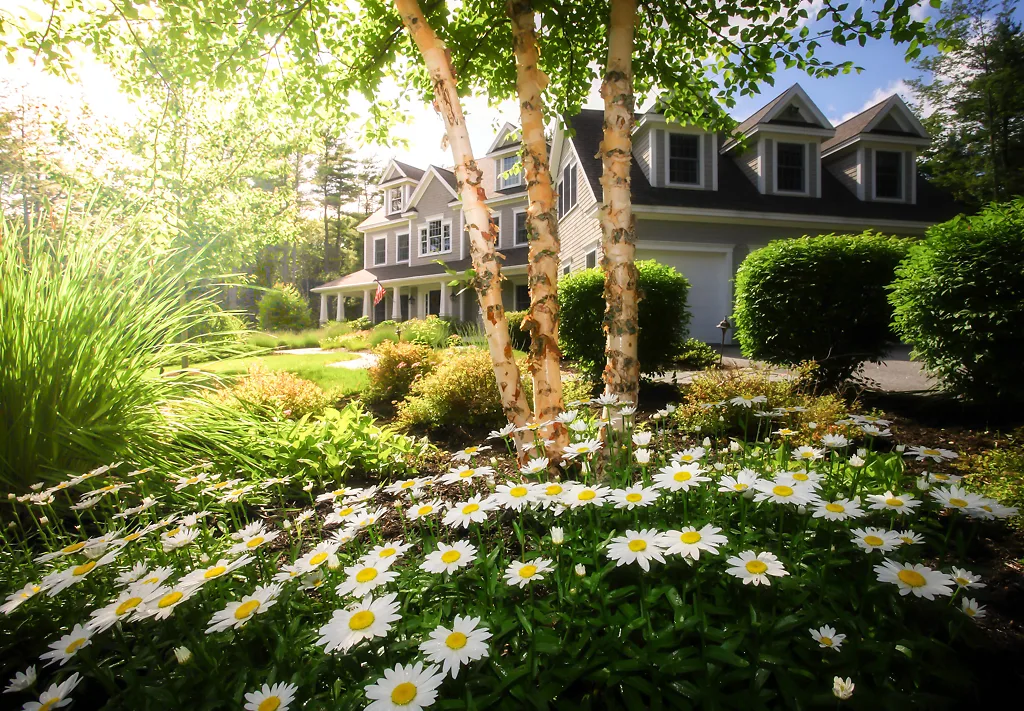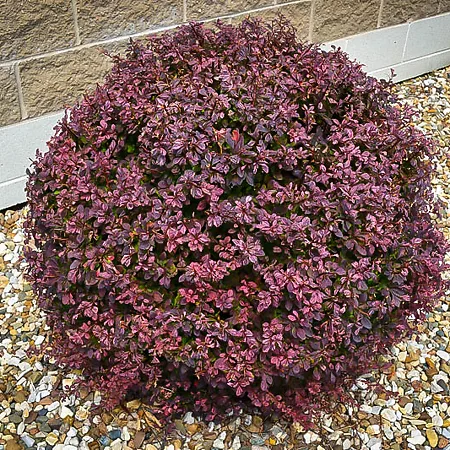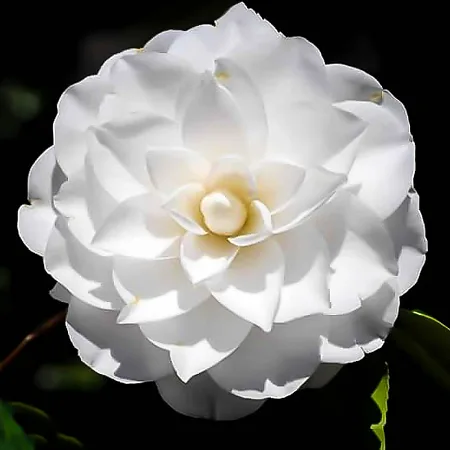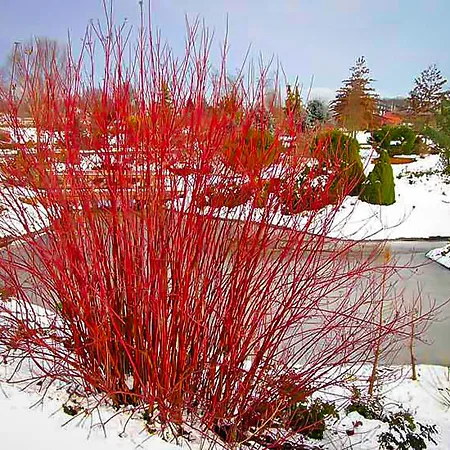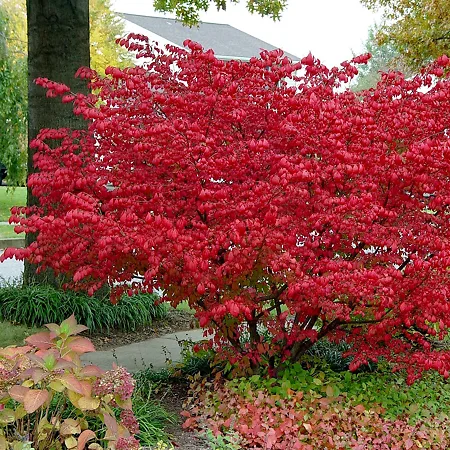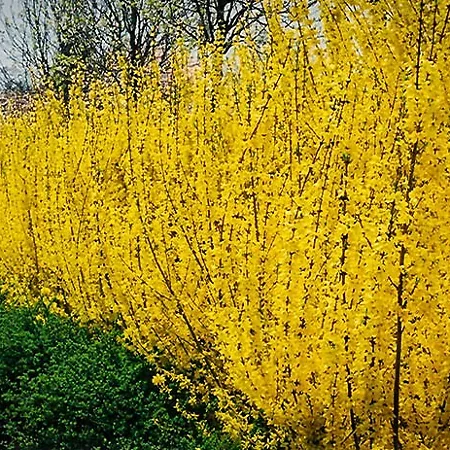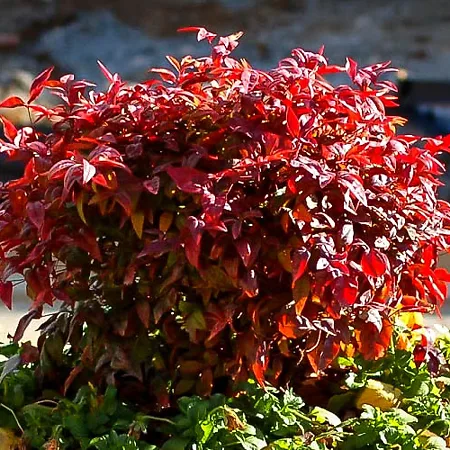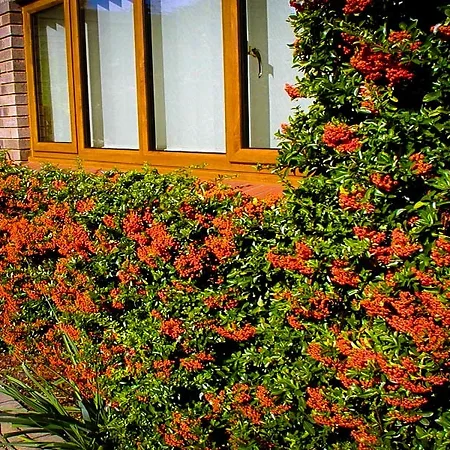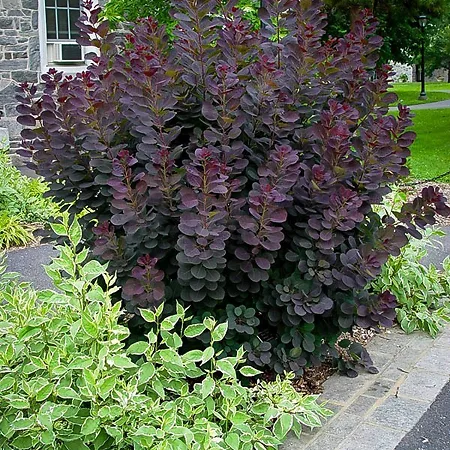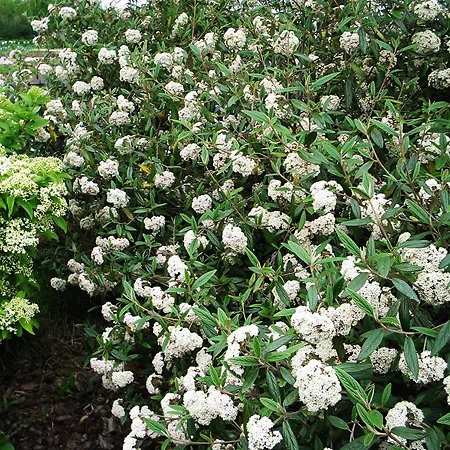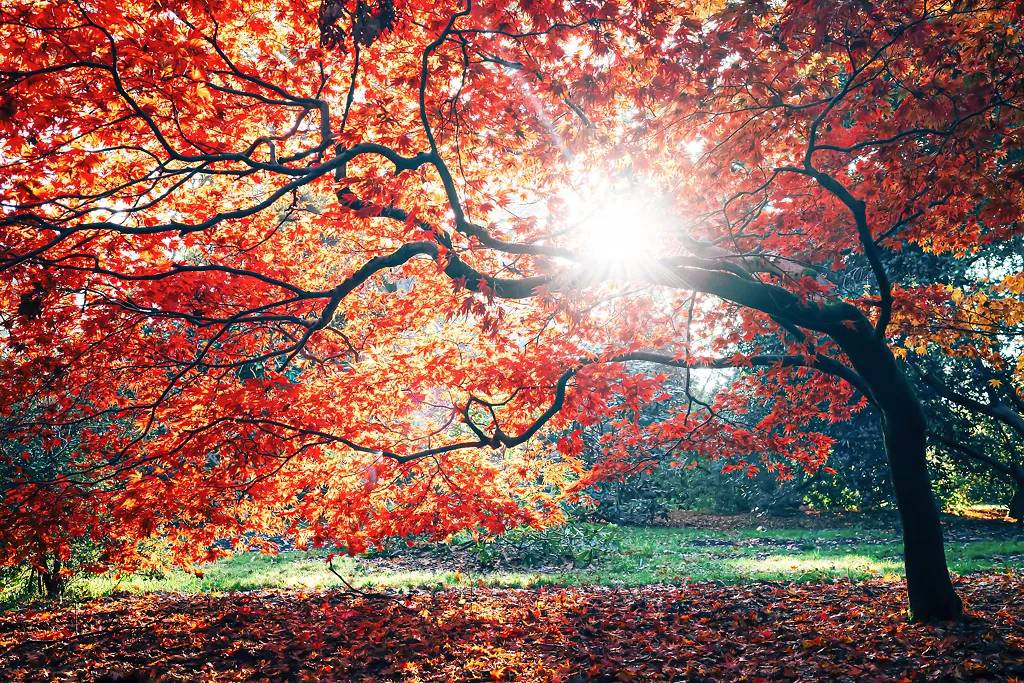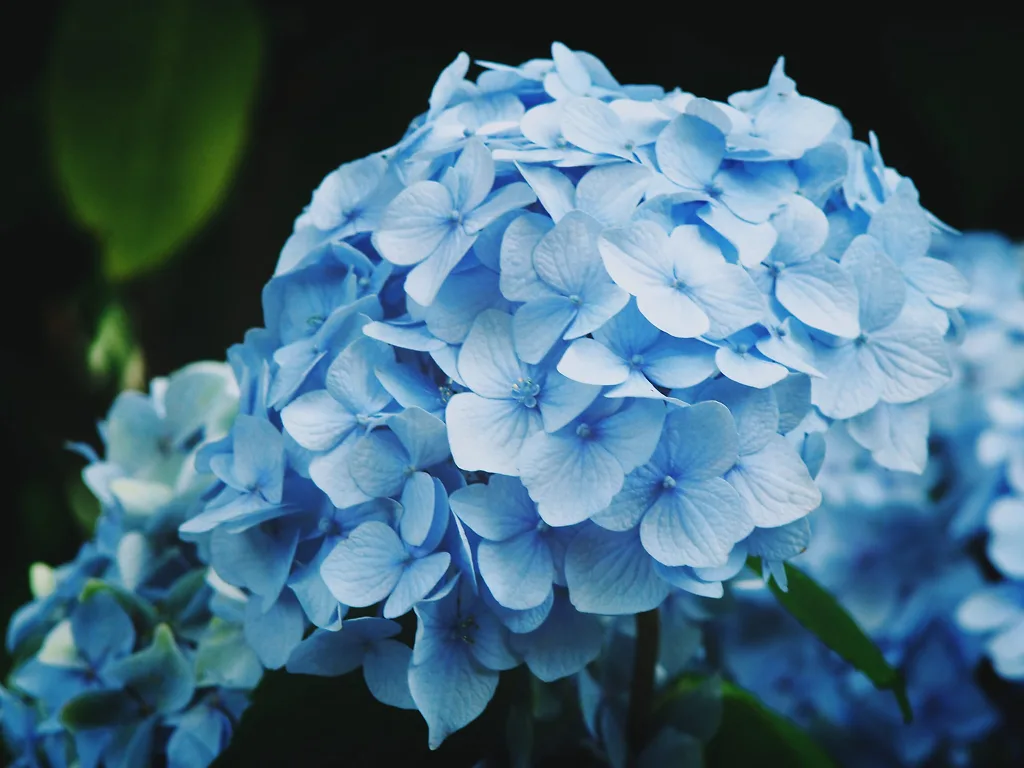Shrubs for Color
If there has been one clear trend in gardening in the last few decades, it has been the growing emphasis on the color of foliage – the leaves of our shrubs. Not so long ago, almost every plant growing in a garden was green, but no longer. Today’s gardens shine with brightly colored leaves – yellows, golds, oranges, reds, purples, blues and silver – and new varieties are constantly being created by plant breeders.
The reason for the development of colorful foliage is obvious. While flowers on our shrubs last just a week or so, and come just once a year, shrubs with colorful leaves are colorful from spring to fall. We can create gardens that are more colorful, even in smaller spaces, and the difficult job of planting so that you always have something in flower becomes less important.
The emphasis in this section of our site is on shrubs that are grown mainly for the color of their leaves. Some of them also have flowers and sometimes berries, but these are often small, and not the reason we grow the plant. Don’t forget, though, shrubs and small trees with spectacular flowers can also have colored leaves. As well, many evergreens of the conifer variety are grown for their color. Check out our evergreen trees, flowering shrubs, and flowering trees – you will find lots of colorful foliage among them too.
Using Colored Shrubs in Your Garden
The ways of using colorful shrubs in your garden are endless, and you can use them wherever you think that green is not interesting enough. But here are some places where colorful shrubs can be especially effective, and really bring your garden to life.
Sunny or Shady? out of the direct sun, green becomes very dark, adding to the gloom of shady parts of your garden. Shade is inevitable in a garden, especially as your plants become larger. Added to that, shade tolerant plants are usually darker green – (they trap more light that way) – and so they look dark and gloomy. The solution? Light colored shrubs, like Euonymus or Nandina, which tolerate darker situations, but have colors that show up in the dark.
Don’t make the mistake of placing dark foliage in shade, as it will largely disappear from just a few yards away. Love those rich, dark Nandina varieties? Plant them in sunnier spots and use the lime-greens and golds in shade. At the other extreme, in bright, sunny places silvers and blues really shine out, while yellows can sometimes look washed-out and faded. Reds look terrific in the sun as well, and so do purples and dark burgundies.
Accent Plants – the most direct way to use colored shrubs is as accents in beds of green foliage. A single brightly-colored plant can really lift your beds to a new level of beauty. If you think your garden beds are getting tired and dull, bring them to life with a scattering of colored shrubs in the gaps – you won’t believe how good those old beds will look now.
Colored Shrubs for Edging – small, brightly colored plants are perfect for edging beds. The ribbon of color emphasized the form of the bed, and it makes a definite line. In some gardens you might want to trim these plants once or twice a year for a neater, more formal look, but if you choose small, compact varieties you can leave the shears in the shed.
Bold Sweeps of Color – in shrubs beds colored shrubs look wonderful in groups, sweeping through the beds, and you can contrast one color against another and get wonderful effects. Mix in ornamental grasses for textural contrast, and glorious landscapes are easy to achieve. When putting one color in front of another, dark in front of light is the most dramatic, and shows off the dark colors best. You can also get some great looks by shading tones, with lighter yellows in front of golds, or bright reds in front of burgundy and near-black.
Tapestry Hedges – our instinct is to plant a hedge of all the same plant – but why? You can make something magical by mixing different colorful shrubs together in a hedge – just choose ones of about the same height and vigor. They will grow together in slightly unpredictable ways, so the result will be a unique, multi-colored effect that replaces a boring green wall with a vibrant, stand-out garden feature.
Easy Planters – A great idea for pots and boxes is to create colorful planters by focusing on foliage instead of flowers. Mix colors together or use a more-restrained palette. The choice is yours, but either way those planters will look great.
The Appearance of Colored Shrubs
When choosing colored shrubs, you will soon notice that many are different colors at different times of year. Some only have colored leaves in spring, turning green for the rest of the year (although they might color again in fall). Others can begin the year one color and darken, or change color completely, later. One of the most difficult things is to keep red foliage in summer, especially in hotter zones, so check carefully for that feature, if you want to avoid disappointment. The amount of light can have an effect too, and many (but not all) yellows will turn greener in shade – of course, that chartreuse tone is fashionable and bright too, so maybe it doesn’t matter much.
Variegated Leaves – an important difference in the way colored shrubs work is the way the leaves are colored. Some plants are variegated – they have green leaves that are edged in yellow, or with yellow in the middle and green down the sides. Some variegations are neat and precise, while others are irregular, with every leaf looking different. Variegation only shows up clearly when you are fairly close to it. At a distance you might just see a brighter green, or a sparkle on the plants. This means that often variegation is best in smaller gardens, or along paths and walks, where you can see the effect close-up. Most variegation is white, cream or yellow, although some plants can show pink or orange variegation.
Solid Color Leaves – other plants have leaves that are completely colored, and these make the most impact. The range of colors available today is extensive – and sometimes you get an amazing range within one group of plants – a look at our Barberry plants will show you their enormous range of possibilities. We find lots of yellows, pinks, oranges, red and burgundies in deciduous shrubs, while blues and silvers are found mostly in conifer evergreens. Often, but not always, the coloring is most intense in spring, on new growth, mellowing over the summer months. If you want strong summer color, the varieties of Crape Myrtle with purple leaves keep their color in summer especially well. For winter color, especially in colder zones, our conifer evergreens, like spruce or cedar, is the place to look.
Colored Stems – especially in colder areas, leaves are in short supply during winter. That doesn’t have to mean ‘no color’, though. There are plants with brightly colored stems that bring a big lift to late fall, winter, and early spring. Top of the list, for color, easy-growing and winter hardiness, are the Dogwoods, which have brilliant red or yellow stems in dense bunches.
Size – no matter what you are looking for, there are colored shrubs in many sizes, from just a foot tall all the way to big plants, 12-foot tall and wide, like the wonderful Smoke Trees, which top their colored leaves with clouds of dusky-pink blooms. If you want larger sized shrubs or small trees, our flowering trees, and our evergreens, are good places to look. There are trees all through those sections which not only have flowers, but colored leaves too.
Form – just as with other shrubs, colored shrubs can be found in a range of forms, from low, rounded plants to narrow, upright ones. If you want more formal shapes, clipping is especially effective with colored shrubs, as it keeps the growth young and at its most colorful. Some of the most compact but brightly-colored shrubs can be found among the Barberry bushes, or for small, colorful evergreen plants, the Nandina department is the place to look.
Growing and Caring for Colorful Shrubs
Colorful Shrubs are varied, but in each description of them you will find details on their care, and tips on how to grow them so they give you their best. Here are some particular ‘rules’ that apply to all shrubs grown for color.
Arranging Colorful Shrubs
Colored shrubs are effective as single specimens in smaller spaces, and they are also very effective when grouped. Plant them in a row for an edging or hedge, or in groups to fill larger areas. When making edging or hedges it is best to space the plants evenly, but when making groups, avoid rows. Instead, scatter the plants over the area you want to cover, spacing them roughly the same distance apart. You get an interesting informal look if you cross plants over between groups, at their edges, rather than having them meet in a neat line – it gives a more ‘natural’ feel.
The only time for using different spacings when laying out lawn specimens. If you have larger lawns, then the same plant in groups of 3 or even 5 can look wonderful. When placing plants in those groups, experiment with spacing, and don’t plant too close, or they will grow into a single mass and spoil the effect. Arranging them well apart, in a triangle, with sides of unequal lengths, usually give the best look.
A useful rule-of-thumb for spacing is to leave a space between plants that is two-thirds of their mature spread. For denser hedges, you could go as close as one-half the spread, but no tighter, or you won’t get good growth. If you go over two-thirds, you will be looking at a ‘polka-dot’ effect for a long time, when what you want is a drift or line of solid color.
Remember what we said earlier to make bold sweeps of color? Laying one color behind or in front of another, depending on the effect you want is important, and should be part of your planning. Blending or contrasting colors and tones gives you a whole palette for painting abstract pictures in your shrub beds – have fun.
Pruning
Some colored shrubs are at their best in spring, and the tones can darken or even fade once summer comes. An easy way to bring back the stronger colors of spring is to trim your plants in early summer. The new growth will usually come out in strong colors. It is also a good idea to feed and water regularly. These things will encourage new shoots, and keep the color coming rich and strong. Hedges of colored shrubs can be more colorful than the same plants left to grow untrimmed, although if they also have blooms, you may be sacrificing them if you trim regularly, or in the wrong season. Those details are given in the extensive coverage of each plant that you find on our site.
The same idea applies when doing annual pruning. Hard pruning will bring a profusion of larger leaves, with stronger color, on many plants. Good examples are our selection of Elderberry (Sambucus) with colored leaves. Hard spring pruning makes plants like that much more effective and colorful. The same is true with Dogwoods, which can be cut almost to the ground every 2 or 3 years, so that they produce long, brightly-colored twigs and dense growth to around 3 or 4 feet tall. If left unpruned the older bark will be brown, with shorter colored twigs.
Other Colorful Shrubs should be pruned as needed, following the standard principle of pruning spring flowering shrubs immediately after they bloom. Shrubs that bloom at the ends of new growth in summer, or those grown just for foliage, are best pruned in early spring, just before new growth begins.
Types of Colorful Shrubs
Colorful Deciduous Shrubs
Among the deciduous shrubs we find a big range of foliage colors, on plants of all sizes and shapes. We have brought the best ones together to make selecting easy:
Barberry
These shrubs come in the widest range of colors of any plant group. Range over our many varieties and you will see shades from gold and lime-green to orange and real reds. Purples and burgundies are available too, and some, like the Rose Glow Barberry, combine pink, red and purple on the same leaf, in random patterns. With their toughness and cold-resistance, plus the range of mature sizes available, you could make a whole garden with nothing but these reliable plants.
For areas where these plants are invasive, we always have a big selection that produce no seeds, and that can be grown everywhere.
Crape Myrtle
These plants were once only big shrubs or trees grown for their colorful flowers, but today there are new, shrubby varieties where the foliage is as least as important as the blooms. They all havedark burgundy or purple leaves, with some coming very close to being black. These dark colors look best in full sun, which is also where these plants will flower best. You will find them among the Flowering Trees. Look for plants in the Black Diamond range, which often have ‘Ebony’ in their names, or grow almost any plant in the ‘Magic’ series. Their color is reliable even in hot zones, and they thrive in heat and drought.
Dogwood Shrubs
For colored winter twigs, nothing beats the Dogwood Shrubs. Hardy even in zone 3, and yet tough enough to also grow in zone 8, these plants light up the winter garden with their red and yellow branches, looking great against both black earth or white snow, depending on the season, and where you live. They love water, so they are ideal by ponds or along streams, but they grow just as well in regular garden beds too. These reliable structural plants are indispensable.
Elderberry Bushes
Not as widely grown as they should be, the Elderberry Bushes bring a lot to your garden. Their lacy foliage is stunning, and it comes in deep purple or golden-lime, which look great grown together. If you prune hard you get the best foliage, on a compact shrub, but if you let them grow larger you get bonus white flowers and red berries too. Plant several, and you can grow them both ways.
Japanese Maples
Although listed among our Shade Trees, many of the Japanese maples have wonderful foliage colors, mostly in shades of red, although some have pink and even apricot spring leaves. Red-leaf Japanese maples are always incredibly popular, and no wonder, because they come in so many sizes, and in upright, spreading or weeping forms. We always carry an extensive range, so take a look if you are looking for a splash of red.
Smoke Trees
When their clouds of blooms float over the leaves in summer, the effect is so beautiful that Smoke Trees are worth growing for that alone. Most of them also have leaves in delicious colors – check out the Royal Purple Smoketree for one of the richest purple leaves available, and the Golden Spirit Smoketree has wonderful yellow to lime-green leaves that really make a splash. These plants are especially useful when you need something larger, and they look wonderful as lawn specimens.
Colorful Evergreen Shrubs
Euonymus
If you have shady areas where not much will grow, let some Euonymus, also called Wintercreeper, loose in them. These amazing evergreens grow where nothing else will, in deep, dry shade, and they are winter-hardy too. With variegated leaves in yellow or white they will climb shady walls in warmer zones, and they will spread across the ground in any zone. When all else fails, it’s time to bring in the Wintercreepers, but they are so easy to grow and reliable that you should make them your first choice, not your last.
Fringe Flower (Loropetalum)
Prepare to be blown away by the stunning color combination of burgundy leaves and hot-red flowers on the amazing Ever Red® Loropetalum. This new shrub, coming out of China, is the latest ‘must have’, and you really must have it. Hardy in zones 7 to 9, this evergreen grows just as well in shade or full sun, and it will give your garden a real color jolt.
Nandina
For reliable foliage with a bamboo feel, Nandina, or heavenly bamboo, is an absolute winner. These dense bushes of glossy leaves come in a broad range of colors, from lime-greens to oranges, and from pinks to dark reds and purples. They grow well in partial shade, and most of them make great edging along paths, or fillers in the foreground of beds. Use them in planter boxes too, for trouble-free color. Most change tones through the year, so they are always putting on a new show, and it’s always a colorful one.
Colorful Conifers
In colder zones there are fewer colorful shrubs that will grow, but don’t worry, because you can still rely on many of the conifer evergreens. A look at our range of Arborvitae will show you several with golden foliage, and for a beautiful orange, check out the Fire Chief Arborvitae. Among the Cedar Trees you will find gorgeous blues for big lawn specimens, and for more blues and silvers, you can’t beat the tough Junipers. These are easy to clip, and they make great formal specimens and hedges. Of course, we can’t mention blue conifers and not point you to our range of Blue Spruce, which are the quintessential blue evergreen for the coldest zones – and in dry heat too.
Conclusion
Wow, exploring Colorful Shrubs is a real color rush – and one you can easily give your garden. If you want color, but you don’t have the time or inclination to grow flowers, then these plants are the way to go. Breeders and nurseries have been working hard on them, and new ones appear every year. For classics and the newest forms as well, you can’t go wrong with our extensive range.
